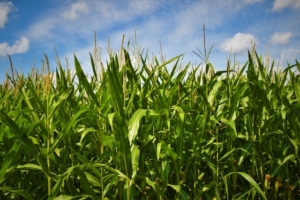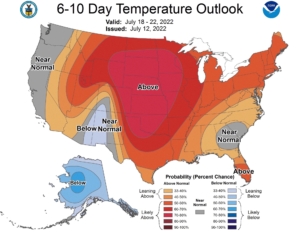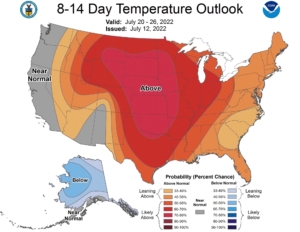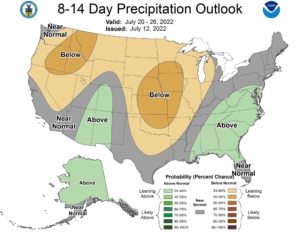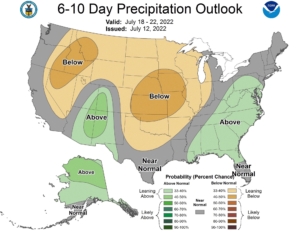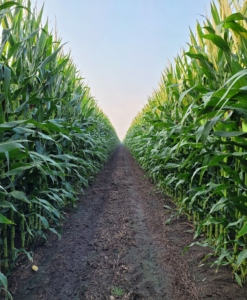
Topics:
– Growing Degree Day Update/Forecast Maps
– What’s going on in my fields?…..Corn Development, ET rates, Disease, etc.
– Insect Update
– Soybean Development
TEMPERATURES & GDU ACCUMULATION:
As of July 26th, we have accumulated approximately the following for Growing Degree Units in 2022:
Planting Date GDD’s2022 Average GDD Departure from average
April 21 1766 1735 + 31 (+ 1 day)
April 28 1700 1685 +15 (even)
May 9 1637 1591 +46 (+ 2 days)
As one can see from the above numbers, the corn crop is moving along at the normal pace. We even lost a day or two since last update two weeks ago. I would agree with this. Silking and pollination occurred at a normal timeframe. Let’s look at the upcoming forecasts….
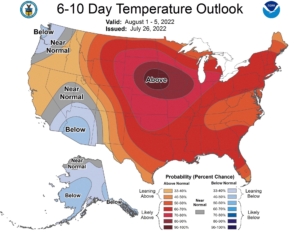
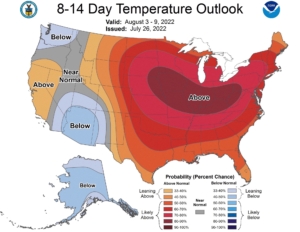
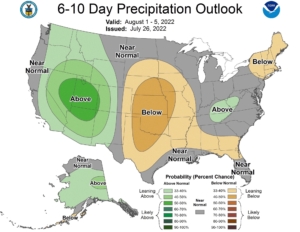
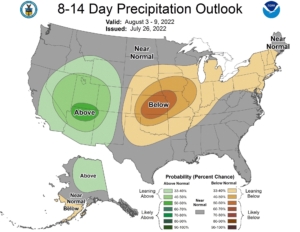
From these maps we see that the next two weeks are predicted to be above normal for temperatures and below normal for precipitation….’and the beat goes on’ as they say….
WHAT’S GOING ON IN MY FIELD?…..Corn Development, Disease, Crop Water Use..
Most of the corn crop is in the R1 (silking) to R2 (Blister Kernel) stage, with some early R3 (Milk). So far I would estimate that most fields in the area are done pollinating, other than the very last planted acres. I would expect to see some uneveness in pollination/silking due to the uneven emergence we saw this past spring, especially in the high residue areas of the field.
- Plant height on the corn crop. This year is a 180 degree swing from 2021. Overall plant heights are much shorter than last year across all fields and shorter than normal really. The sands especially are shorter than normal…shorter than I have seen for some years. Ear height also is shorter than a year ago. Last year, most fields had ear height at head high or above. This year it is chest to groin high. This should be a positive for harvest and residue management heading into next spring. However, the factory above ground is not as robust maybe as some years….
- A captured pollen grain takes about 24 hrs. to grow down the silk to the ovule where fertilization occurs and the ovule becomes a kernel.
- Overall pollination seems to be good so far. Finding the usual checkerboard pattern in some fields and some sandy fields are showing a little more skips on the butt of the ear on the bottom side of the ear. These are the first silks out so could be potential water stress. Many of the sandy fields have what we would call a ‘Droughty’ look to them, meaning the tassel did not extend out above the last leaves, but more just ‘poked out’ and is almost ‘sitting’ in the last leaf. This phenomenon could have affected early pollen drop as well. The crop has definitely been pushed hard over the last month. At first glance, ear set seems to be normal across hybrids….finding normal rows around each hybrid and ears are starting to elongate….
- At R1, potassium uptake is essentially complete, and nitrogen and phosphorous uptake are rapid. Last round of N should be going on over the next 7-10 days.
- Blister Kernel occurs approx. 10-14 days after Silking. Starch has begun to accumulate in the watery endosperm and the kernels are beginning a period of rapid, steady, dry matter accumulation that will continue until physiological maturity in approx. 50-60 days after silking.
- At Blister Kernel, maximum ear length is achieved. Although not as severe as at Silking, stress over the next two weeks can still have a profound effect on yield through kernel abortion.
- Kernel abortion from stress can occur through the Milk stage(18-22 days after silking), however when the plant reaches Dough, kernel abortion will no longer take place, and any yield reduction from then on out will be from lower test weight.
- As far as sunlight is concerned, we are currently running about 8% percent below normal over the last 14 days (last year at this time we were 10% below normal), or from V14-Blister Kernel. Sunlight, of course, is now a much bigger yield factor, since we are now beginning the crucial grain fill period. As such, how much sunlight and when it occurs during the grain-fill period, will play a role in overall yield and late-season plant health. Lack of sunlight early in the grain fill period (i.e. right now) can increase potential for the ear to tip back.
- Extra stress will occur if sunlight is reduced and temps (especially nighttime) are higher than average. This stress occurs because, since temps are high (especially nighttime temps), the energy demand on the plant is higher than average; couple this with reduced photosynthesis, and this leads to greater energy in the plant just going to maintain itself and not to filling the ear. It is an axiom in corn production that when you have to run your air conditioner at night, it is not good corn growing weather.
- Relative Humidity over the past two weeks has been 8% below normal, with a daily average of 68% RH during this time frame. This has led to increased ET rates. This, coupled with continued above normal temps over this same timeframe, and we can see why crop water demands continue to be high….and how much of a God-send the rains of the past couple of weeks have been.
- ET rates for the past 15 days have been averaging .31 inch/day. This is .04 inches above the normal of .27 inch/day. Total ET usage over the past 15 days has been 4.65″. The rains, indeed, were a blessing!! The forecasted warm temps will keep these ET rates high for the next two weeks yet….keep in mind corn at Blister Kernel is average of .28/inch per day in normal weather and soybeans are now at peak usage at R3 stage….over .30 inch/day normal. Maintaining an adequate soil moisture profile will be key over the next three weeks or so. As you think about irrigation needs over the next two weeks, keep temperatures and relative humidity in mind as we move forward to see what actually occurs to help reduce potential water stress or potential over watering. If dew points are low (dry mornings), that means relative humidity is low, and ET rates will stay up higher than normal. On the flip side, if heat indices are high in which a 95 degree actual temperature feels like 110 degrees, then relative humidity is high and ET rates will be average to below average. Forecasts for next few days are calling for low dew points meaning potentially higher ET rates than normal.
- So far corn leaf diseases continue to be on the low side. Seeing mainly Bacterial Leaf Streak, which has increased quite a bit over the last two weeks. Some fields showing first grey leaf spot as well and we have seen a few Northern Corn Leaf Blight lesions around. So far not seeing an increase in disease in the areas that had hail back in June, most likely due to the hot, dry conditions. Crop Focus – Northern Corn Leaf Blight
- Fungicide application should be on on the first planted fields and going on now, and into next week on the later planted fields. You want to protect the plant when it is working the hardest, which is silking through milk stage (which is NOW!). Reminder, Fungicide will not help control bacterial leaf streak.
CULTIVATION

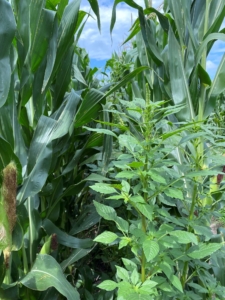
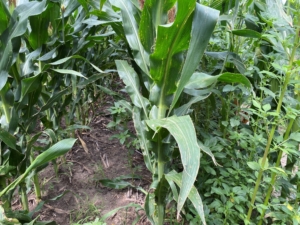
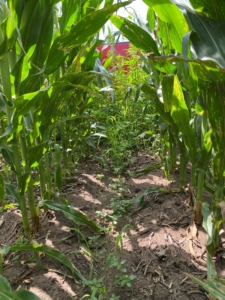
My ‘Hot Take’ for the day….I know the word cultivate is a ‘four-letter word’. However, the above pictures show what cultivation pass can mean on Palmer/Waterhemp control. The first two pictures are side-by-side rows of cultivation and no cultivation. The third picture is another look at that. The last picture is where the cultivator lifted up to cross a pivot road…notice the difference. Granted weeds will come back in the cultivator rows, but MUCH smaller and less seed production. Cultivation needs to be a tool in the toolbox again….
SOYBEAN UPDATE
- Much of the crop is in the late-R2(full flower) to R3(pod set) stage of growth. The April planting dates are in the late R3 to early R4(full pod) stage. This is ahead of normal in my opinion. The heat has also pushed the soybeans along. Just as in corn in the sands, it appears that plant height in soybeans on the sand knobs and no-till fields will be shorter than normal. Some 30″ row soybeans in the sand will ‘just’ canopy.
- Peak water use, nutrient demand, and overall energy demand in the plant occurs at R3 and into R4 stage….i.e. right now and into the next few weeks!
- ET rates in soybeans reach peak at R3 stage (.30+ in/day) and will continue to stay high through R6(full seed). See comments above on corn ET rates, as the same applies for soybeans. One will need to be careful not to water constantly to help reduce disease potential (see below on white mold) due to a constantly ‘wet canopy’. If White Mold becomes a problem, it will be best to water at night and leave off during the day so the canopy has some chance to dry out. In heavy soils, when irrigation is needed, we recommend running a heavy irrigation amount (.80 to inch+) and then leaving it sit for a while.
- R3 is the prime growth stage for fungicide/insecticide applications….some early planted and early maturity fields are in this stage right now with most all fields reaching this next week. Same goes for any nutrient application such as N, as well. Now and into next week will be excellent time for application.
- So far we have not seen any white mold in area fields. Weather conditions of the past two weeks may have led to decreased potential for this disease to develop, or at least delay its onset. August weather will determine the severity of any white mold occurrence. Any 2nd treatments for White Mold need to go on at R3 and should be going on now and into next week. See the attached link for White Mold management. Managing White Mold in Soybeans We recommend Aproach or Delaro fungicide for any white mold control. High temps and dry mornings will slow the disease down.
INSECT UPDATE – Corn & Soybeans
- Keep scouting for Western Bean Cutworm larvae. Moth flight has been higher than last year, but so far infestation levels have been on the low side, just enough to warrant treatments in most sandy fields. From GDU data, we expect that the flight is 80% complete. Any potential treatments should be on, or going on ASAP, as we are now finding small larvae on the ear tips, on top of the silks. Any delay in treating, and they will be too far into the ear tip for control. Overall infestation levels are not super high, but many sandy fields still have the potential to have infestation levels that will cause economic damage.
- Corn Rootworm pressure has been somewhat lower than last year, although fields that were not beetle-bombed last year still saw higher incidence of root lodging and heavy adult beetle counts. Adult rootworm beetle control should already be on, or going on now if planned….Steward insecticide by FMC is an excellent choice for control
- Overall insect pressure in soybeans has been very light. Begin scouting next week for Bean Leaf Beetles as they will begin feeding on developing pods over the next few weeks. So far we are not seeing much for Soybean Aphids. If you have made an insecticide application already, or are going to, this should give you season long control unless a severe outbreak of one of these insects occurs.
- Dectes Stem Borer – be on the lookout for this insect starting now and into harvest. We saw quite a bit of this in our area last year, especially south and east of Elgin. Watch field edges first and let us know if you are seeing wilted and dying plants as they move in from the grassy edges. If you see this, keep these fields in mind for earlier harvest. Dectes Stem Borer in Soybeans
- Seeing a few small colonies of Corn Leaf Aphids(dark green aphid) in area corn fields. They tend to proliferate under cooler and damper conditions, so we may see their numbers increase in the area. They are not an economic concern, but you may begin to notice them as you walk through your fields.
- We are just starting to see our first Spider Mite colonies…..very small and on the very bottom leaves. However, if temperatures turn out as forecasted and relative humidity stays lower than average, infestation levels will increase. Keep an eye out for this insect over the next month or so.
Please mark your calendar for the Pioneer Annual Customer Appreciation Supper which is set for Friday, August 19th. Invite will be coming out soon!
Please contact us with any questions or comments you may have! Thank you for your business!!
Starman Seed Service, Inc.

